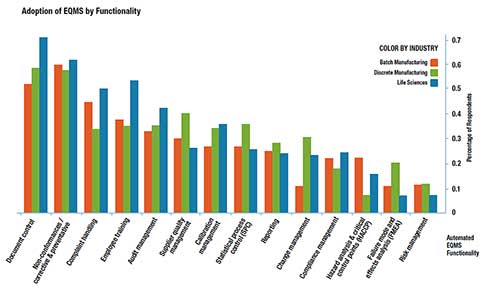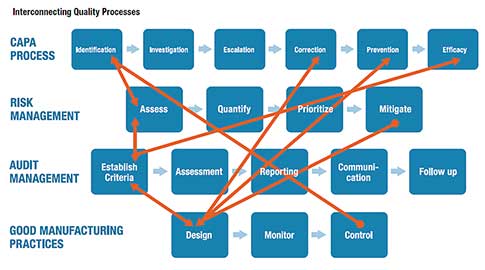You know that old saying “if it’s not broke, don’t fix it?” Unfortunately, that is the thought process many executives adopt around quality management. It is not necessarily that their quality management systems are broken, per se, but the challenge of having disconnected quality systems and data sources has grown to become so normal that it has become just something they “deal with” or “make work.” In a perfect world, however, these resources should be enablers of ever-improving quality.
There is a gap in the ability of many organizations to effectively deliver quality products and processes, and our research during the past several years has revealed that building closed-loop quality processes with enterprise quality management software (EQMS) is the bridge. EQMS transforms many of the traditionally siloed quality efforts that are causing roadblocks to improvement today. However, because this is a relatively new and emerging software space, some have found it difficult to figure out how to approach such an investment.
In this article, we will address how you can identify three gaps in your quality management system so you can move toward a closed-loop environment. We will also discuss next steps for making such an investment.
Quality gap No. 1: people and leadership
You may be wondering why an assessment of people-oriented resources is needed in a gap analysis meant to highlight how closed-loop quality can improve business performance. Quality is largely dependent on culture and leadership, and modern technology systems such as EQMS are instrumental to deliver the communicative and collaborative capacities needed to get the most out of those resources. Look at current vs. ideal resources and think of how EQMS will facilitate a stronger quality culture and empower both site and corporate leaders to make better decisions. In many cases, the enterprise transparency provided by closed-loop quality processes can drive a stronger culture.
Quality gap No. 2: business processes
A major driver of EQMS adoption that we are seeing concerns the inefficiencies of disparate processes such as corrective and preventive actions (CAPA) and a lack of consistency in the documentation for communicating and analyzing open issues. As seen in figure 1, these two functionalities were the most widely adopted.
To identify gaps, it is often helpful to develop a flowchart to map your current process capabilities from beginning to end. You can then apply your desired quality management capabilities. When mapping quality risk management, for instance, you may find that any open issues or those flagged with higher risk never get escalated to a higher level. In reality, however, you may want this process to extend out to corporate if it is left open for a certain time, or if it reaches a particular level of criticality.
In many cases, EQMS can compound this jump, helping to extend the capability uniformly across the enterprise. Extending a standardized quality risk management process or system can have a dramatic effect on your enterprise risk portfolio and quality metrics.
Quality gap No. 3: technology
EQMS can play a central part in standardizing and building out end-to-end business processes, and connecting those processes on a common platform. In a process which was only conceptual not long ago, many companies today are actually closing the loop on quality issues originating across the value chain with EQMS. Figure 2 presents a high-level map demonstrating how quality processes can connect with one another.
When identifying your gaps, review current IT architecture and identify which process and quality data source gaps can be filled with EQMS. If your current capabilities have a number of instances of the processes listed in figure 2, it may be time to consider standardizing one or more with EQMS.
EQMS is good at standardizing and consolidating quality processes, but it can also be a key point of integration with other enterprise systems. In some cases, this means integration with or extending capabilities found within enterprise resource planning (ERP), manufacturing operations management (MOM), product lifecycle management (PLM), customer relationship management (CRM), and supply chain management (SCM).
By centralizing process data on a common platform, information can be automatically routed from one data source to another, providing an opportunity for the cross-functional communication that is critical to achieving operational excellence. Closed-loop quality is often a major gap that today's complex companies identify and leverage EQMS to fill.
Build your own closed-loop quality environment
EQMS is a critical solution for achieving closed-loop quality, but many organizations struggle to develop an actionable plan for moving toward such an environment. If you are interested in progressing forward in your quality management journey, join us on June 17th for a webinar on this topic, where my colleague Mehul Shah will be discussing next-generation strategies for quality management. Reserve your spot (and access our free report on this topic) here.
Web source:
Three Major Quality Management Gaps… | Quality Digest



Nenhum comentário:
Postar um comentário